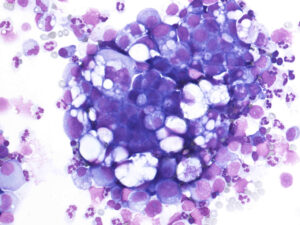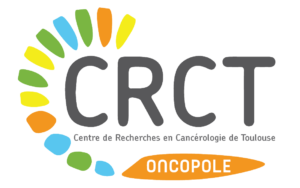
Better diagnosis and treatment with targeted therapies.
Dr C.Basset
There are already emerging therapies that target PI3Ks. These are treatments currently in clinical trials or already approved by the authorities in certain cancers, such as PIQray, a PI3Ka inhibitor, in metastatic breast cancer.
In this project, the SigDYN team works with patient samples routinely analysed by the Department of Anatomy Pathology and Cytology, IUCT-Toulouse. Metastatic cancer commonly manifests as a serous effusion, resulting from an accumulation of fluid in the pleural, pericardial and peritoneal cavities. Malignant serous effusions are characterised by the presence of neoplastic cells in the serous fluid. The detection of these cells is a sign of tumour progression and is associated with shorter survival.
Microscopic examination of the effusions quickly gives an indication of malignancy and histological type based on cell morphology. The final diagnosis can be confirmed by the immunocytochemistry technique which also provides a specific etiology. However, the use of these techniques to improve therapeutic molecular targeting or prognosis remains limited. Moreover, this material arriving fresh in the anatomopathology laboratory can be directly frozen or cultivated in vitro. These samples are easily exploited in translational research, and the resulting ex vivo patient cell cultures allow innovative therapeutic combinations to be tested in a personalised manner.
The objective of this project co-led by Dr. C. Basset is to develop and automate the analysis of general characteristics, such as the aggregation properties of cells, in addition to those already used routinely, in order to identify new morphological characteristics with prognostic value, to discover new molecular determinants from these characteristics and, finally, to propose new therapies based on this knowledge.
Thus, tumour cells, but also their inflammatory and immune environment, will be studied individually with an approach targeting the PI3K pathway, a pathway activated in more than half of cancers, including ovarian cancers, and which is also a key pathway in the control of transformation and cell morphology.


